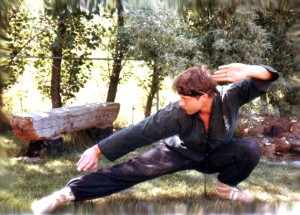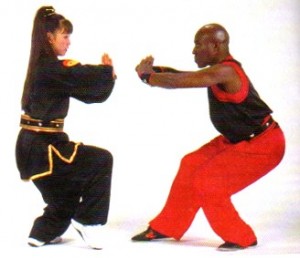The Hidden Meanings Behind The Flash
By Stefan Verstappen,Originally published in Black Belt Magazine Sept .05
Chinese styles are often criticized as being impractical, showy and lacking in practical application. The criticism is usually heard from the eclectic styles that focus on street fighting and self defense and it is true that a Tai Chi or White Crane form will do you little good in a cage fight. But then again combat is not only what forms were designed to teach.
Forms are the heart and soul of a style containing not only fighting techniques, but also the strategic and philosophical principles of that style.Chinese forms are some of the most complicated and confusing because they contain hidden meanings that, like a puzzle, can only be solved by persistent study. Although each form has its own specific applications and interpretations the following keys may help you to decode the secrets of the classical Chinese forms.
Hiding Techniques
One way in which Chinese forms differ from the better known Japanese and Korean forms in that the latter use the principle of keeping only what was useful in combat and have tended to discard those movements that where not. Watching Japanese and Korean forms being performed one can recognize the techniques being used. In contrast, when watching Chinese forms many movements appear strange and theatrical and the combat applications are not always clear. One reason is the notoriously secretive attitude surrounding the Chinese styles. The old masters were said to have hidden their best techniques by changing them to make them incomprehensible to anyone that did not possess the key to understanding the style.
A Chinese folk tale may provide a clue as to why the old masters were so secretive and it goes like this. Once there was a young man who gained a reputation by visiting different martial arts schools and defeating the instructors in sparring contests. When he arrived in a town or village he would first discreetly enquire into the local master’s whereabouts and then secretly spy on the master during his practice. After several days of spying he would have learned the master’s style, strategy, strengths and weaknesses and then he would issue his public challenge. Knowing what to expect, the young man was able to defeat many teachers and thus gained his reputation.
One day the young man arrived at a village nearby the mountains in which a Taoist Monk who was also a Kung Fu master was said to live. After inquiring among the villagers the young man learned that the Master practiced early every morning in a clearing.Rising before dawn, the young man went to the clearing and hid in the bushes where he could secretly watch the old monk as he practiced. After several days of spying the young man felt he knew the monk’s secrets and he challenged him to a contest.
The old monk obliged to meet him in the village for a sparring match the next day. During the match the young man was soundly beaten and made to look the complete fool.
Confused the young man asks, ” I studied your technique for days, but when you fought you used movements I had never seen, how is this possible?”
The monk replied, “It is wise to use the strategy of `Know your Enemy’ but several days ago I sensed someone was watching me so I employed another strategy. When I practiced I changed the movements so that the real techniques were hidden, and when you challenged me I guessed it must have been you who had spied on me earlier. I knew what you would expect and, so I was able to turn the advantage against you.”
Whether the story is true or false the tendency to keep the real applications of a form secret is still apparent and many teachers are reluctant, or at best vague, in explaining the real purpose behind the movements.
One method of hiding technique is by `blending’ the techniques together. In Japanese Katas there usually is a `stop’: a pause after each technique to show precision and focus.
In Chinese forms the techniques are often blended together without a pause between the end of one technique and the start of the next. It is this blending of techniques that give Chinese forms their characteristic fluidity, and their mystery, since without having trained in the style you would not recognize many of the techniques being performed.
These masters would teach the hidden applications to only a select group of students, referred to as `Closed Door’ sessions. During the regular `Open’ class all students would learn the same movements, but only the most trusted students would be taught the true applications behind the movements. In this way the style’s most important techniques were kept secret from outsiders and those not deemed worthy of the knowledge.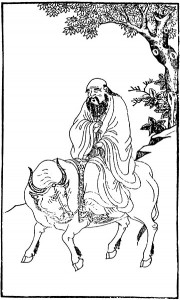 Breathing Techniques
Breathing Techniques
Many Kung Fu forms contain breathing exercises called Chi Gung which combines deep abdominal breathing, dynamic hand movements, and visualization. In the so called `Hard’ styles the hand movements are performed slowly using dynamic tension. In `Soft’ styles the hand movements are done relaxed with the focus on visualizing Chi (Internal Energy) flowing throughout the body. Some breathing exercises include vocalizations.
Striking with a Crane Hand is usually accompanied by a crane benzodiazepine call produced by a sudden contraction of the diaphragm, similar to a technique taught in modern voice classes.A more unusual vocal technique is a long descending wail that starts in the falsetto range and then descends through the octave to the bass range. The sounds made during a form are designed to show breath control. Unfortunately Bruce Lee made these vocalizations famous and now no moron’s pantomime of kung fu is complete without the obligatory whining and wailing.
Conditioning
There are several ways in which physical conditioning exercises are incorporated into a form. In the Chinese forms the stances tend to be much lower than they would be in real combat. Maintaining low stances throughout the form is excellent for developing leg strength, endurance, and provides cardiovascular benefits.Another conditioning technique is to exaggerate the movements which requires greater effort and flexibility.
For example, in the Long Fist form the arms are held stretched out away from the body and the techniques are large and exaggerated. This works the muscles in the shoulders as well as the waist and relies on gravity resistance much like a modern Pilate’s routine. For more strenuous conditioning, weights in the form of heavy brass or iron rings were worn around the forearms. Kicks are also done higher in a form than would be done in application.
When practicing forms many kicks are aimed at head height, although in self-defense, most teachers admonish against kicking higher than the solar plexus. The high kicks in a form help to increase flexibility and balance.
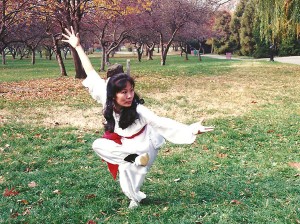 Finesse
Finesse
Finesse techniques are usually found in weapons forms and are meant to demonstrate the performer’s expertise in handling the weapon. Like a gunfighter spinning his revolver on one finger before holstering, these techniques are almost all show but do require considerable skill.
Weapons such as the sword, spear, and staff are routinely spun about the body, passing the weapon from one hand to another, behind the back, overhead, and around the neck, in what are known as Flowers. The finesse techniques are incorporated more for beauty than combat although some are surprisingly effective.
Forms occasionally include movements that are symbolic of the style. Some represent the origins of the form or religious influences such as the famous Kung Fu bow done by pressing the right fist to the left palm. This is said to have originated in the Shaolin temple and represents the Buddhist principle of non violence, the open palm stopping the fist.
Another possible meaning is that it is a secret hand sign left over from the times when martial arts were taught in secret societies. In this case the fist represents the sun and the palm the crescent moon. In Chinese writing the moon and sun symbols written together spells “Ming” which was the reign name for the last native Chinese dynasty the Ming Dynasty. From 1644 to 1911 many secret societies were dedicated to overthrowing the Ching dynasty and restoring the old Ming. The hand signal was a way for members, many of whom were martial artists, to recognize each other.
Little known in the West is the relationship of Chinese Opera and Kung Fu with both arts exchanging techniques. Chinese Opera schools devote much of their curriculum to Kung Fu and gymnastics. Chinese Operas usually have battle scenes where the performers must wield and spin weapons and battle several opponents in choreographed fight scenes similar to those found in modern movies. Jackie Chan and Samo Hung both learned their Kung Fu while training to be Opera performers. While Chinese opera incorporated kung fu techniques, Kung Fu also borrowed many dramatic techniques from the Opera.
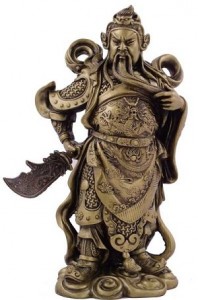 One of the most famous characters in Chinese Opera and Kung Fu schools is Kwan Gung. Kwan is the both the god of war and the patron saint of martial arts. He is characterized by his use of a particularly heavy halberd called a Kwan Dao (Kwan’s blade) and by his long black beard. A statue or picture of General Kwan is usually found in every Kung Fu club and in earlier time a rusty old Kwan Dao was often displayed in front of the club’s entrance like barber’s pole. When using the Kwan Dao in a form there are several dramatic gestures that have no practical applications but have obviously been adopted from the theatre such as a pause in the form in which the practitioner pretends to stroke a long beard.
One of the most famous characters in Chinese Opera and Kung Fu schools is Kwan Gung. Kwan is the both the god of war and the patron saint of martial arts. He is characterized by his use of a particularly heavy halberd called a Kwan Dao (Kwan’s blade) and by his long black beard. A statue or picture of General Kwan is usually found in every Kung Fu club and in earlier time a rusty old Kwan Dao was often displayed in front of the club’s entrance like barber’s pole. When using the Kwan Dao in a form there are several dramatic gestures that have no practical applications but have obviously been adopted from the theatre such as a pause in the form in which the practitioner pretends to stroke a long beard.
Other examples of dramatic gestures are found in the animal styles. Each style will incorporate movements that embody the characteristics of the animal such as the graceful open arm hops and turns of the White Crane, the facial grimaces and ape-like gestures of the Monkey, and the hypnotic bobbing and weaving of the Preying Mantis. Some of these techniques have a combat application while others are for aesthetic reasons only.
Conclusion
Long before written language heroic tales of great deeds and battles were acted out in pantomimes in front of campfires as a way of passing cultural traditions onto the next generation. In a sense Chinese forms are a continuation of this ancient tradition. The next time you practice a Kung Fu form know that you are also a part a cultural tradition the goes back before history began.
